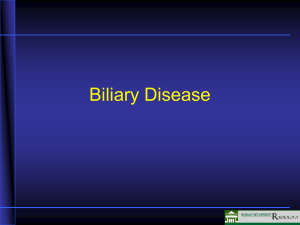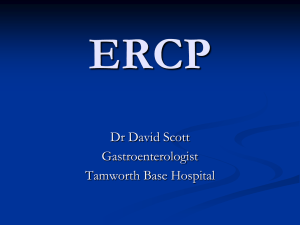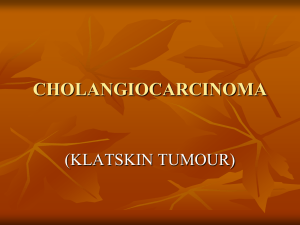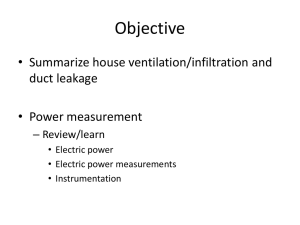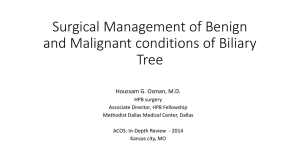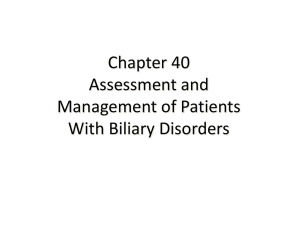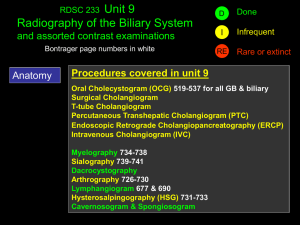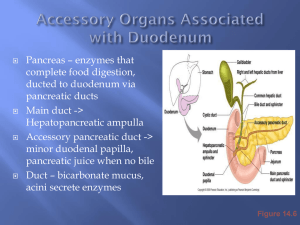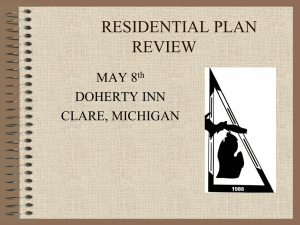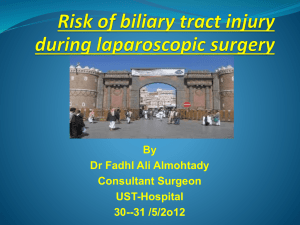Endoscopic management of Laparos
advertisement
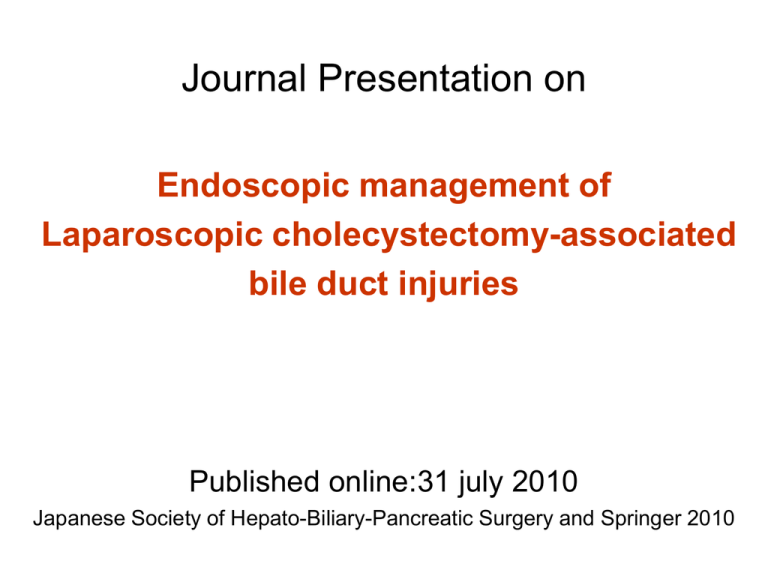
Journal Presentation on Endoscopic management of Laparoscopic cholecystectomy-associated bile duct injuries Published online:31 july 2010 Japanese Society of Hepato-Biliary-Pancreatic Surgery and Springer 2010 CHAIRPERSON DR.MD MATIUR RAHMAN ASSOCIATE PROFESSOR, SURGERY UNIT-2 AND PRINCIPAL MYMENSINGH MEDICAL COLLEGE SPEAKER DR. SUBRATA SARKER IMO ,SURGERY UNIT -2 MYMENSINGH MEDICAL COLLEGE HOSPITAL INTRODUCTION • In the past decade laparoscopic cholecystectomy (LC) has gained wide spread acceptance and replaced conventional open cholecystectomy as the treatment for cholecystolithiasis. • However, LC is associated with a higher incidence of bile duct injuries that is major bile duct injury is 0.1-0.5% during LC performed for any indication. A review of 1.6 million cholecystectomies in Medicare patients in United States demonstrated a.0.5%incidence of bile duct injury, unchanged between 1992-1999. • These data suggest that the occurrence of bile duct injury in LC has not decreased despite increasing experience. INTRODUCTION (contd.) • Traditionally, bile duct injuries have been managed by surgical reconstruction with biliary enteric anastomosis. • The reported symptomatic anastomotic strictures ranges from 9 to 25%. • Meanwhile ,endoscopic treatment has demonstrated resolution of complications comparable to that achieved with surgery , but with lower morbidity and mortality. • This study views 11-year experience with the endoscopic approach to all types of bile duct injuries from LC. PATIENTS AND METHODS PATIENTS • Files from April 1997 to June 2008 were reviewed from an ERCP database maintained and during the study period, LC was performed on 1797 patients and biliary tract injuries occurred in 21 (1.17%) patients. • This study addressed a total of 17 patients. there were 11 men and 6 women with a median age of 60 years( range 41-84 years). • Inclusion criteria for this study were: - biliary leakage, -biliary strictures, or -biliary transection PATIENTS (contd.) that were judge by gastroenterologist participant in the study to be secondary to the prior LC.. • Exclusion criteria included the followings -History other than LC that involve the biliary tract and - Injuries recognized during surgery in patients who never presented for ERCP. Table :1 Defined classification of suspected major bile duct injuries after initial ERCP • Type A: cystic duct or peripheral hepatic leakage • Type B: major hepatic duct injury leakage • Type C: stricture of the common hepatic duct with or without leakage • Type D: complete transection of the common hepatic duct • Type E: others METHODS An ERCP catheter was inserted deep into bile duct ,and a 0.035-in. guide wire (Jagwire ,Terumo) was advanced in to the bile duct. For patients with the leakage , a 5-to 7F endoscopic nasobiliary drainage (ENBD) tube was placed without endoscopic sphincterotomy (EST). Improvement of the leakage was assessed using cholangiography through an ENBD tube 1 week later. If improvement of leakage and no signs of secondary ductal stenosis were confirmed ,the ENBD tube was removed. However if the leakage had not improved, a single 7F plastic stent was placed for additional 1-2months. METHODS (contd.) For patients with stenosis, a single 7F plastic stent was placed for 1-2months without EST. Repeat ERCP along with the stent removal and cholangiography via the ENBD was performed. If improvement of the stenosis was confirmed, the tube was removed and the treatment protocol was concluded. If improvement of the stenosis was not confirmed new 7F plastic stent was placed for an additional 1-2months. METHODS (contd.) Endoscopic intervention was not attempted in patients with complete biliary transection or occlusion , as they were deemed unsuitable for endoscopic therapy; rather they under went percutaneous transhepatic biliary drainage (PTBD) or surgical reconstruction. Fig. 1: Major hepatic duct injury leakage (type B). a. One day after laparoscopic cholecystectomy, Endoscopic Retrograde Cholangiopancreatography (ERCP) showed extravasation of contrast dye from an aberrant segmental extrahepatic branch of the right hepatic duct (arrow). b. X-ray of 5F endoscopic nasobiliary drainage (ENBD) without sphincterotomy. c. One week after ENBD placement, resolution of leak was confirmed (arrow) and the ENBD was removed. Fig. 2 Stricture of the common hepatic duct without leakage (type C). a Eight days post-laparoscopic cholecystectomy, ERCP was performed to evaluate a new elevation in serum hepatobiliary enzyme levels. Stricture of the common hepatic duct (arrows) was observed. b This stricture was managed with the placement of a single plastic 7F stent for almost 2 months. c After the stenting, resolution of the stricture (arrows) and normalization of serum hepatobiliary enzyme levels were confirmed RESULT • The profiles of all seventeen patients with bile duct injuries incurred during LC are -symptomatic gallstone disease 15 (88.2%), -acalculous cholecystitis 01 and -emphysematous cholecystitis 01. • 7 of the 15 patients(41.2%) suffered from acute cholecytitis and three of these cases were severe enough to necessitate percutaneous transhepatic gallbladder drainage (PTGBD). . • Table 2:Profiles of the 17 patients with bile duct injury Indication for LC Symptomatic gallstone 15 Cholecystitis without gallstone 1 Emphysematous cholecystitis 1 Operation LC 9 LC converted to open cholecystectomy With surgical primary repair 5 Without surgical primary repair 3 Injury manifestations Bile leak 13 Excessive postoperative pain and fever 2 Jaundice 1 Dilated bile duct on imaging 1 RESULT (contd.) In the 8 of the 15 patients, LC was converted to open cholecystectomy; five of these patients primary repair of bile duct injuries and the remaining of the three patients were converted to open repair for indications other than bile duct injury (eg; adhesion ) • Manifestation of bile duct injury included -bile leak in 13(76.5%) -exacerbated postoperative pain and fever in 2(11.8%). -Jaundice in 1(5.9%) and -dilated bile duct on imaging in (5.9%)patient. The cases were classified after initial ERCP: RESULT (contd.) • Nine patients with the leakage underwent ENBD as initial treatment. • Two other patients were underwent placement of a single plastic 7F stent. • Seven patients (77.8%)improved clinically and on imaging over an average of 5.2(range4-7 )days .Two patients had not completely improved after 1 week with ENBD, but they improved after the placement of a 7F stent . The cumulative success rate was 100%. • Four patients with stricture successfully underwent insertion of a single 7F stent on the first attempt, and all patient improved clinically and imaging 56-111 days (mean 62.0 days). Total clinical success rate was 100% with EBS. RESULT (contd.) Fifteen patients were available for evaluation after stent removal .The mean follow up period was 2436 days( range 173-4674).All patients experienced complete resolution of symptoms without recurrence. • Table -6 : Long-term follow-up after stent removal Type A +B Type C Symptomatic recurrence 0/11 0/4 Secondary stricture 0/11 0/4 Other factors associated with bile duct injury 0/11 0/4 DISCUSSION • The incidence of bile duct injury during LC is higher than that of laparotomy . Despite the fact that many studies have addressed the prevention of bile duct injuries ,their incidence is still higher ,at 0.5% for LC. • Only 30%of these injuries are recognized at the time of operation and the consequences of a major bile duct injuries can be severe. Surgical repair of bile duct injury has been the main stay of treatment for many decades. In general the result of bilioenteric bypass operations are good in 80-95% of patients, But the peri-operative mortality rate is 20%-42%, with a mortality rate of 6%-20%. DISCUSSION (contd.) • In addition, during long term follow up, after surgical repair, 5%25% of patients will have relapsing symptoms because of recurrent stricture formation at the anastomosis site. • Most authors have advocated endoscopic placement of plastic stent to manage bile duct leakage (North America and Europe,), • In Japan, ENBD is selected as initial treatment • Some authors advocate sphincterotomy while performing stenting. • In this study, the biliary sphincter whenever possible preserved, specially in younger patients to avoid post operative pancreatitis.. LIMITATIONS First, the intervention was not blinded. Second, this was a single center study and the result may not be generalized. Third, the numbers in this study were too small to perform a multivariate analysis for evaluation of condition of patients, the time of the procedure or the length of the follow up. CONCLUSION • ENBD for leakage and biliary strictures are safe and effective treatment for LC associated injuries. • Interventional ERCP with ENBD as the initial treatment for leakage and biliary stenting for stricture is safe and effective for LC associated biliary injuries and this procedure can be considered an alternative to a biliary anastomosis in patients without complete biliary duct transection. THANK YOU ALL
